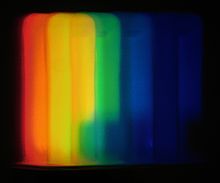

Dispersion is the phenomenon in which the phase velocity of a wave depends on its frequency.[1] Sometimes the term chromatic dispersion is used to refer to optics specifically, as opposed to wave propagation in general. A medium having this common property may be termed a dispersive medium.
Although the term is used in the field of optics to describe light and other electromagnetic waves, dispersion in the same sense can apply to any sort of wave motion such as acoustic dispersion in the case of sound and seismic waves, and in gravity waves (ocean waves). Within optics, dispersion is a property of telecommunication signals along transmission lines (such as microwaves in coaxial cable) or the pulses of light in optical fiber.
In optics, one important and familiar consequence of dispersion is the change in the angle of refraction of different colors of light,[2] as seen in the spectrum produced by a dispersive prism and in chromatic aberration of lenses. Design of compound achromatic lenses, in which chromatic aberration is largely cancelled, uses a quantification of a glass's dispersion given by its Abbe number V, where lower Abbe numbers correspond to greater dispersion over the visible spectrum. In some applications such as telecommunications, the absolute phase of a wave is often not important but only the propagation of wave packets or "pulses"; in that case one is interested only in variations of group velocity with frequency, so-called group-velocity dispersion.
All common transmission media also vary in attenuation (normalized to transmission length) as a function of frequency, leading to attenuation distortion; this is not dispersion, although sometimes reflections at closely spaced impedance boundaries (e.g. crimped segments in a cable) can produce signal distortion which further aggravates inconsistent transit time as observed across signal bandwidth.
- ^ Born, Max; Wolf, Emil (October 1999). Principles of Optics. Cambridge: Cambridge University Press. pp. 14–24. ISBN 0-521-64222-1.
- ^ Dispersion Compensation. Retrieved 25-08-2015.